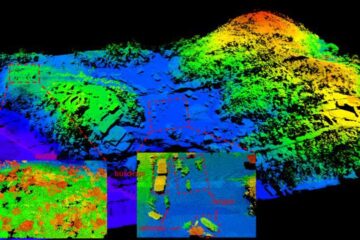CCNY, Lehman experts find ’magnetic flames’ in molecular magnets exhibit properties akin to fire

In a groundbreaking experiment, researchers from The City College of New York (CCNY) and Lehman College have measured the speed of magnetic avalanches and discovered that the process is analogous to the flame front of a flammable substance. The discovery of a “magnetic flame” could make it easier for engineers to study the dynamics of fire.
Magnetic avalanches occur when the polarity of a molecular nanomagnet is changed suddenly and sufficient energy is released to cause a chain reaction that changes the polarity of the other molecular nanomagnets in a crystal.
Yoko Suzuki, a graduate student at The City College, devised an experiment to measure the progress of a molecular avalanche through a crystal of Mn12 (manganese) acetate using an array of tiny micrometer sized Hall sensors placed underneath the specimen. Ms. Suzuki observed that the avalanche began at one end of the crystal and propagated at speeds of a few meters per second in the form of a “flame” front that released magnetic energy into the crystal.
“Molecular nanomagnets are the first-known magnetic materials in which the magnetic energy density is sufficient to ignite a ‘magnetic flame,’” said Dr. Myriam P. Sarachik, Distinguished Professor of Physics at CCNY and Ms. Suzuki’s mentor. “This could open a potentially important new road for investigating the dynamics of fire in flammable substances because, unlike chemical burning, magnetic burning is non-destructive, reversible and more readily controlled.”
The investigation into the propagation of magnetic avalanches grew out of a theory suggested by Eugene Chudnovsky and Dmitry Garanin. Dr. Chudnovsky, Distinguished Professor of Physics at Lehman College, collaborated with Ms. Suzuki and Professor Sarachik in the present work.
Chudnovsky and Garanin had theorized that under the right circumstances a magnetic system could be made to emit laser type radiation. They suggested that a magnetic avalanche might initiate such laser action. Measuring the speed of the avalanche would aid in the examination of the theory.
When experimentalists at CCNY discovered that the avalanche propagates at a constant speed of a few meters per second, Professor Chudnovsky proposed that the effect is, in fact, “magnetic burning”. Comparison between theory and experiment confirmed his conjecture.
A paper reporting the discovery of “magnetic burning” by Ms. Suzuki, Professors Sarachik and Chudnovsky and coauthors has been accepted for publication in Physical Review Letters. In addition to CCNY and Lehman College, scientists from the Weizmann Institute in Israel and the University of Florida participated in the project, providing the Hall sensors and crystals, respectively.
Media Contact
More Information:
http://www.ccny.cuny.eduAll latest news from the category: Physics and Astronomy
This area deals with the fundamental laws and building blocks of nature and how they interact, the properties and the behavior of matter, and research into space and time and their structures.
innovations-report provides in-depth reports and articles on subjects such as astrophysics, laser technologies, nuclear, quantum, particle and solid-state physics, nanotechnologies, planetary research and findings (Mars, Venus) and developments related to the Hubble Telescope.
Newest articles

A universal framework for spatial biology
SpatialData is a freely accessible tool to unify and integrate data from different omics technologies accounting for spatial information, which can provide holistic insights into health and disease. Biological processes…

How complex biological processes arise
A $20 million grant from the U.S. National Science Foundation (NSF) will support the establishment and operation of the National Synthesis Center for Emergence in the Molecular and Cellular Sciences (NCEMS) at…

Airborne single-photon lidar system achieves high-resolution 3D imaging
Compact, low-power system opens doors for photon-efficient drone and satellite-based environmental monitoring and mapping. Researchers have developed a compact and lightweight single-photon airborne lidar system that can acquire high-resolution 3D…





















